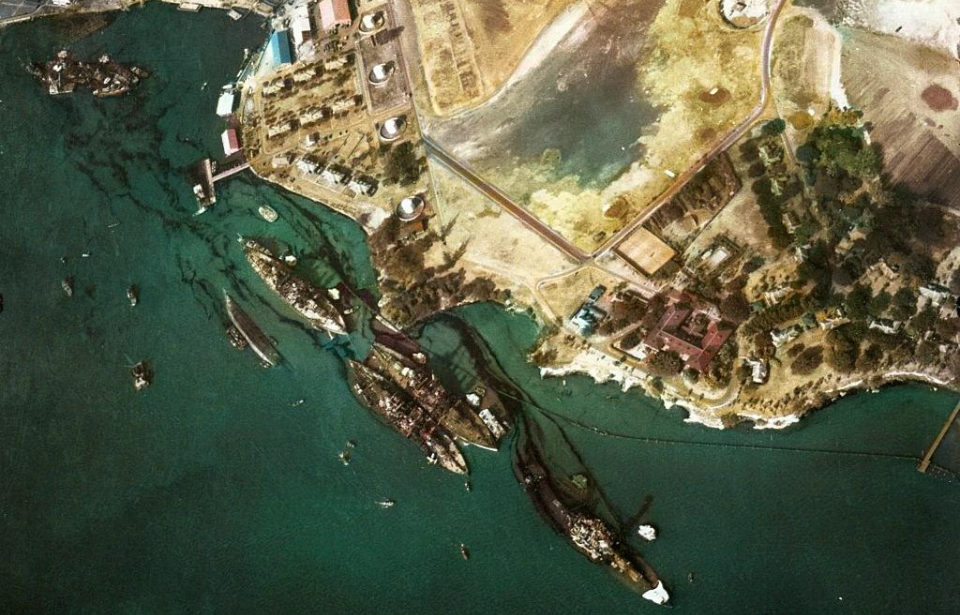Prior to the attack on Pearl Harbor, nine American ships were moored off of Ford Island, to deter Japan from its imperialistic ambitions. Known as Battleship Row, they varied in age, armaments and service history, and each was manned by dedicated crewmen, many of whom lost their lives on December 7, 1941.
While the aim may have been to stop the Japanese from colonizing additional areas of the Pacific, the goal of the air and sea attack against the American naval base was to damage the US fleet so much that the country couldn’t declare war. As history later showed, this wasn’t the case, as President Franklin D. Roosevelt and the US Congress approved a declaration of war against Japan the next day.
The following is a list of the vessels anchored at Battleship Row, complete with a brief overview of their service history and their role in defending against the enemy attack on Pearl Harbor.
USS Arizona (BB-39)
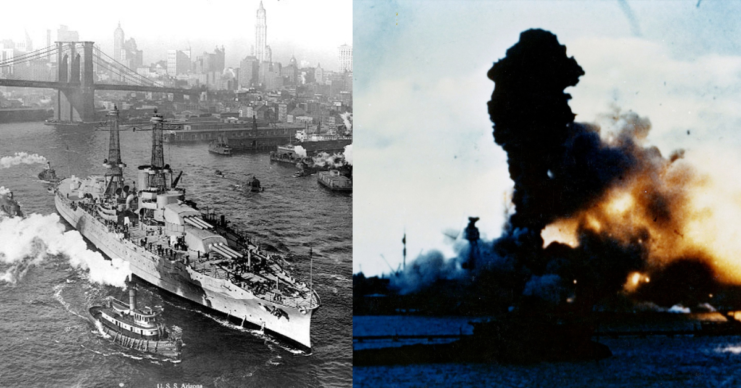
The USS Arizona (BB-39) was commissioned in October 1916 as the second of two Pennsylvania-class battleships. Tasked with monitoring the East Coast during World War I, she later served as part of the escort that followed the USS George Washington (ID-3018) as the ocean liner transported President Woodrow Wilson to the Paris Peace Conference.
After undergoing modifications during the interwar period, Arizona and the US Pacific Fleet were moved to Pearl Harbor in April 1940. She was moored at Battleship Row when the Japanese launched their attack and almost immediately was struck by a 1,760-pound projectile.
The hit caused Arizona‘s fuel and munitions to ignite, with the subsequent explosion lifting the battleship out of the water. A total of 1,177 individuals onboard the vessel perished, including Rear Adm. Isaac C. Kidd, the commander of Battleship Division One. While an effort was made to retrieve the bodies trapped inside, the decision was ultimately made to leave over 900 within the wreckage.
Today, the USS Arizona Memorial marks where the wreck of the sunken battleship sits below the water. It was erected, in part, thanks to the efforts of Elvis Presley, who held a fundraising concert that raised $54,000 for the Pacific War Memorial Commission.
USS Utah (BB-31/AG-16)
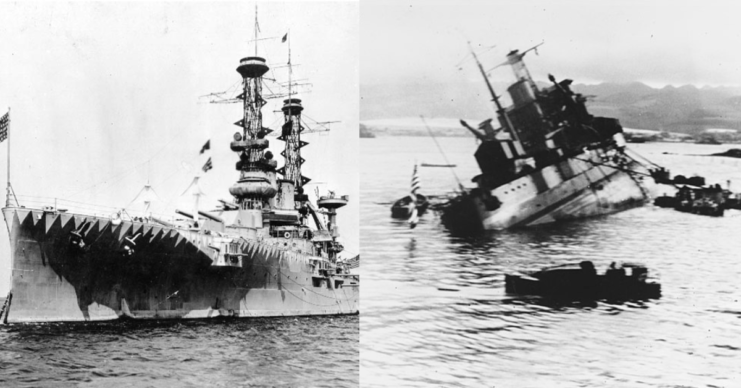
The USS Utah (BB-31/AG-16) was the second and final Florida-class dreadnought battleship. Commissioned in August 1911, she participated in the US occupation of Veracruz during the Mexican Revolution. She served as the flagship of Battleship Division 6 (BatDiv 6) during WWI, protecting Ireland’s Bantry Bay against German raids, and, similar to the USS Arizona, was among the ships to escort the USS George Washington to France.
Over a decade after the First World War came to an end, Utah was converted into a target ship that doubled as a training vessel for gunners. When the Second World War began, she served as a target for bombers launched from American aircraft carriers, before being moored at Battleship Row prior to the Japanese attack on Pearl Harbor.
Crewmen aboard Utah were the first to see the approaching enemy aircraft on December 7, 1941, but mistook them for friendlies. It wasn’t until the bombs began to fall that they realized what was happening. While the target ship wasn’t intended to be a target, six torpedoes were mistakenly dropped on Utah, causing her to flood and list.
At 8:12 AM, Utah rolled onto her side. While 461 crew members were able to escape the vessel, 58 were sadly killed, including Chief Watertender Peter Tomich, who was posthumously awarded the Medal of Honor for his efforts to keep vital machinery running while his crew mates escaped.
Attempts were made to salvage Utah, but they were unsuccessful. Her hull remains half-submerged in Pearl Harbor, with the remains of those who perished still within the wreckage.
USS Oklahoma (BB-37)
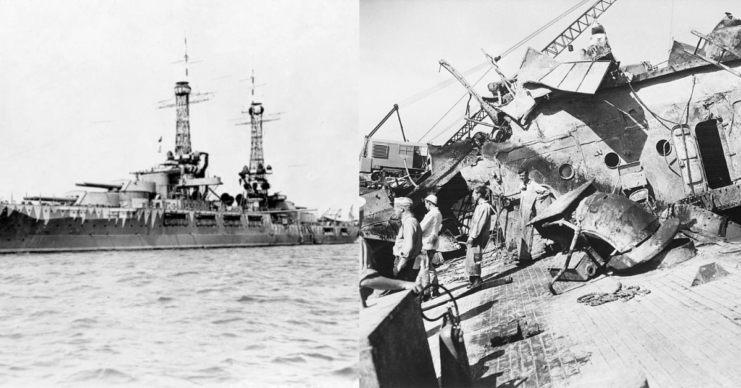
The USS Oklahoma (BB-37), a Nevada-class battleship, entered service in May 1916. She protected Allied convoys as they crossed the Atlantic during WWI, and just like the aforementioned vessels was among the ships to escort the USS George Washington to the Paris Peace Conference.
After undergoing modernization during the interwar period, Oklahoma was sent to Europe to aid in the evacuation of refugees and American citizens affected by the Spanish Civil War. She was then sent to Pearl Harbor as part of the US Pacific Fleet, where she performed routine patrols and was used in training exercises.
When the Japanese launched their attack on the naval base, Oklahoma was moored at Battleship Row. She was among the first targets, with aircraft from the enemy aircraft carriers Akagi and Kaga striking her with five torpedoes and strafing those who tried to escape.
Not wanting to abandon the fight, many of the surviving crewmen boarded the USS Maryland (BB-46) and manned anti-aircraft batteries. Of Oklahoma‘s numbers, 429 were killed or listed as missing, including Silver Star recipient Father Aloysius Schmitt and Medal of Honor awardees Seaman James Ward and Ensign Francis Flaherty.
A number of those who perished aboard Oklahoma were unknowns, prompting the Defense POW/MIA Accounting Agency (DPAA) to launched the USS Oklahoma Project. Of the 388 exhumed remains, 355 were identified by the time the Pentagon wound down the program in 2021.
USS Pennsylvania (BB-38)
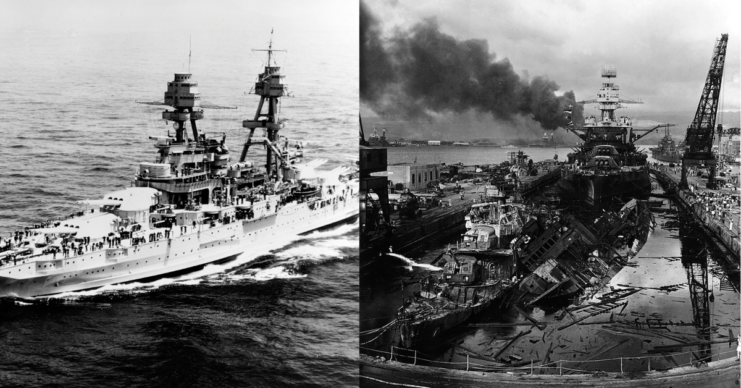
The USS Pennsylvania (BB-38) was the lead ship in her class of super-dreadnought battleships, which were notable for being equipped with an extra pair for 14-inch .45-caliber guns. Serving as the flagship of the Atlantic Fleet and, later, the Battle Fleet, she spent the majority of the interwar period stationed in California.
Drydocked with two destroyers, the USS Cassin (DD-372) and Downes (DD-375), near Battleship Row on December 7, 1941, Pennsylvania suffered relatively little damage during Japan’s surprise attack on Pearl Harbor. While attempts were made by the enemy to flood the drydock, they proved unsuccessful. Only when strafing led Cassin and Downes to become engulfed in flames did the American forces voluntarily flood the area.
After undergoing repairs, Pennsylvania served in the Pacific Theater, supporting a number of operations throughout the Second World War. Among them were the Aleutian Islands Campaign, the American landings at Kwajalein and Eniwetok Atolls, and the Battle of Peleliu, among the bloodiest engagements in US Marine Corps history. She was also present at the Battle of Okinawa, but was forced to withdraw after suffering damage from a torpedo strike.
Following World War II, Pennsylvania was allocated to the target fleet during Operation Crossroads, the codename for the US military’s nuclear tests in Bikini Atoll. While she survived both blasts, she was too contaminated to continue her service and was scuttled in February 1948.
USS Nevada (BB-36)
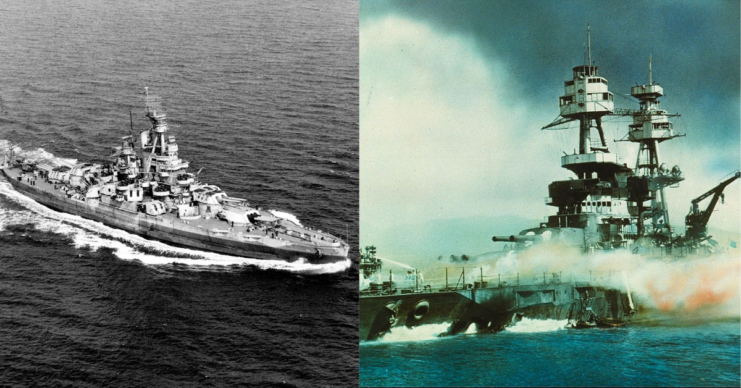
Entering service in 1916, the USS Nevada (BB-36) was dubbed “the greatest [battleship] afloat” by The New York Times, thanks to her triple gun turrets and “all or nothing” method of armor. During the First World War, she escorted convoys to the British Isles, after which she performed exercises and underwent modernization.
Unlike the other vessels anchored at Battleship Row on December 7, 1941, Nevada wasn’t moored directly next to another ship. She was the first to open fire on the attacking Japanese aircraft, and she managed to survive hits from a Type 91 Mod 2 torpedo and munitions dropped from Aichi D3A Type 99 “Val” carrier bombers.
Returning to combat in May 1943, Nevada was sent to Europe, where she participated in the Allied landings on D-Day. She targeted shore defenses along the Cherbourg Peninsula, after which she was moved to southern France to provide fire support during a raid against a reinforced fortress.
After her service in Europe, Nevada was sent to the Pacific Theater, where she assisted in the battles of Iwo Jima and Okinawa, suffering kamikaze attacks and constant shelling. Following WWII, the battleship served in Operation Crossroads, surviving the nuclear tests. She then sat inactive for two years, after which she was sunk during a four-day naval gunfire exercise.
USS West Virginia (BB-48)
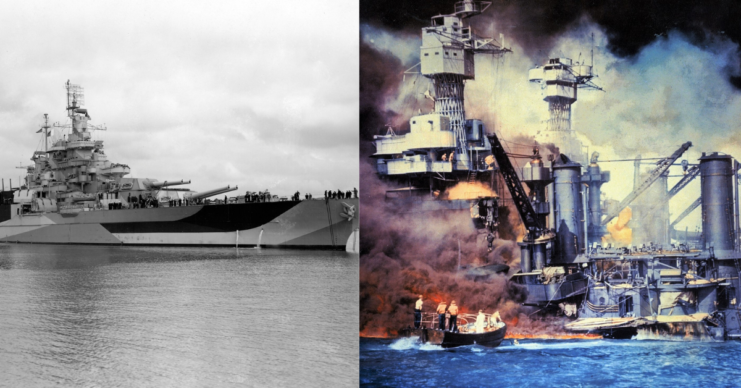
The USS West Virginia (BB-48), a Colorado-class dreadnought battleship, was seen as a step-up from the previous Tennessee-class, thanks to her much more powerful main battery of eight 16-inch guns. Commissioned during the interwar period, the vessel was moored at Battleship Row during the attack on Pearl Harbor, becoming the victim of seven Type 91 torpedo strikes and two armor-piercing shells that had been converted into bombs.
While counter-flooding measures were taken to prevent West Virginia from capsizing, she did wind up sinking into the shallow water. A total of 106 crewmen died during the attack, including three who were trapped within for 16 days. While it was known the sailors were stuck in the battleship, the risk was too high to save them – drilling a hole would have caused water to rush into the hull, while using a torch may have resulted in a deadly explosion.
After being refloated, West Virginia was repaired and sent to the Pacific to serve in the Philippines Campaign, leading the line at the Battle of Surigao Strait. The battleship then supported the invasion of Leyte as part of the shore bombardment force and the Battle of Leyte Gulf. She also participated in the battles of Iwo Jima and Okinawa, before returning troops to the US during Operation Magic Carpet.
Following WWII, the vessel was decommissioned and assigned to the Pacific Reserve Fleet, where she remained until she was sold for scrap in 1959.
USS Maryland (BB-46)
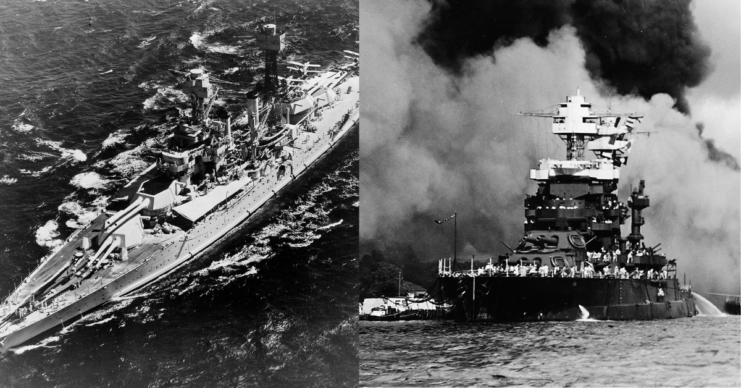
Nicknamed “Fighting Mary” and “Old Mary,” the USS Maryland was commissioned in July 1921. Moored along Battleship Row on December 7, 1941, she was among the first to shoot down the attacking Japanese aircraft, thanks to her protected position inboard of the USS Oklahoma. Able to bring all of her anti-aircraft batteries into action, she continued to fire skyward, even after being struck by two armor-piercing bombs.
While the Japanese claimed to have sunk Maryland, she’d actually managed to stay afloat during the attack on Pearl Harbor. She underwent repairs and was soon returned to action, playing a supporting role at the Battle of Midway, and during the Battle of Tarawa in November 1943 bombarded the shore, destroying a number of Japanese positions.
She then participated in a whole host of battles, including Kwajalein Atoll, Saipan, Leyte Gulf, Okinawa and Iwo Jima, before serving as a transport vessel during Operation Magic Carpet. Following the war, she was placed in the Pacific Reserve Fleet, where she remained until she was sold for scrap in July 1959.
USS Tennessee (BB-43)
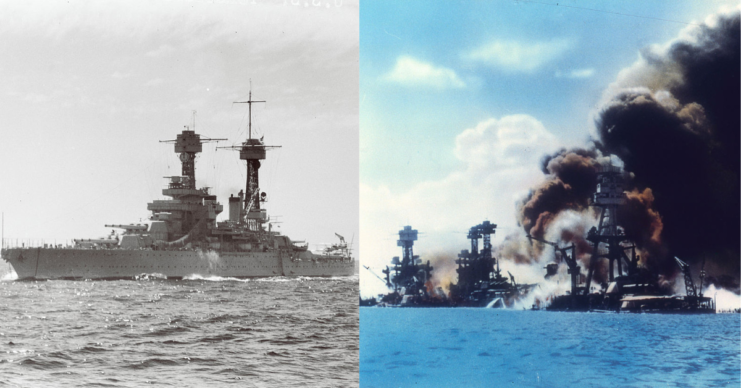
The lead ship in the Tennessee-class of dreadnought battleships, the USS Tennessee (BB-43) was commissioned in June 1920. After participating in goodwill visits and naval exercises throughout the interwar period, the vessel was moored at Battleship Row when the Japanese launched their surprise attack on Pearl Harbor on December 7, 1941.
After being showered by oil following the explosion onboard the USS Arizona, Tennessee suffered two bomb hits. However, neither detonated properly, causing minimal damage. The battleship then operated off the West Coast, after which she was sent to the Pacific Theater, participating in the Aleutian Islands Campaign, as well as the Gilbert and Marshall Islands Campaign.
A number of engagements followed in the South Pacific before Tennessee was sent north to shell Japanese forces during the battles of Iwo Jima and Okinawa. Surviving a kamikaze attack, she spent the final months of WWII in the East China Sea, after which she was involved in the American occupation of Japan.
After returning to the US in 1946, the battleship was placed in the Pacific Fleet Reserve and, similar to a number of vessels on this list, was scrapped in 1959.
USS California (BB-44)
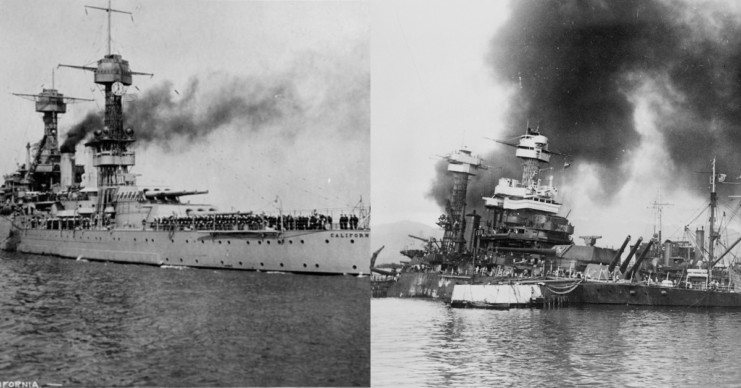
Commissioned in August 1921, the USS California (BB-44) served as the flagship of the Battle Fleet during the interwar period. After performing a number of training exercises and goodwill visits, she was moored at Battleship Row in Pearl Harbor, where her crew was preparing for an inspection when the Japanese launched their surprise attack.
Initially suffering strafing from the enemy aircraft, California‘s crew was able to return adequate fire – that is, until they ran out of ammunition. This opened a spot for a pair of Nakajima B5Ns to drop their torpedoes, the damage from which contributed to the battleship flooding as the morning went on.
Four members of the battleship’s crew were awarded the Medal of Honor for their heroics on December 7, 1941 – Jackson Pharris, Robert Scott, Thomas Reeves and Herbert Jones – three of whom were presented with the decoration posthumously.
More from us: USS Missouri (BB-63): American Battleship and Site of the Japanese Surrender
After being raised and repaired, California was sent to the Pacific Theater, where she performed in the Mariana and Palau Islands Campaign, as well as the Philippines Campaign. The vessel survived a kamikaze hit during the invasion of Lingayen Gulf in January 1945, after which she supported the American forces fighting on Okinawa.
She was laid up following WWII and sold for scrap in 1959.
